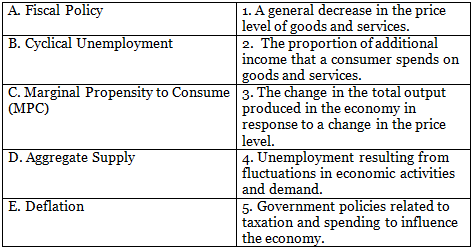Worksheet: Determination of Income and Employment- 2 | Economics Class 12 - Commerce PDF Download
| Table of contents |

|
| Multiple Choice Questions |

|
| True and False Questions |

|
| Match the Following |

|
| Very Short Answer Questions |

|
| Short Answer Questions |

|
Multiple Choice Questions
Q1: Which of the following is an example of a flow variable in the context of national income accounting?
(a) Total savings in an economy
(b) Stock of capital goods
(c) Government debt
(d) National debt
Q2: In the circular flow of income, which of the following represents withdrawals from the income flow?
(a) Government spending
(b) Investment by firms
(c) Imports
(d) Exports
Q3: Which of the following is a tool used by the government to control inflation?
(a) Increase in government spending
(b) Decrease in interest rates
(c) Increase in taxes
(d) Decrease in money supply
Q4: What does the term 'Gross Domestic Product (GDP)' represent?
(a) Total value of all goods and services produced within a country in a specific period
(b) Total value of all goods and services produced and consumed within a country in a specific period
(c) Total value of all goods and services produced within a country and exported to other countries
(d) Total value of all goods and services imported by a country
Q5: Which of the following is a component of aggregate demand?
(a) Government expenditure
(b) Imports
(c) Savings
(d) Taxes
True and False Questions
Q1: An increase in exports leads to a decrease in a country's GDP.
Q2: Frictional unemployment occurs when individuals are unemployed due to mismatch between their skills and available job opportunities.
Q3: The Phillips curve illustrates the relationship between inflation and unemployment, showing an inverse relationship between the two.
Q4: Investment is considered an injection into the circular flow of income.
Q5: The multiplier effect refers to the initial change in spending leading to a larger change in national income.
Match the Following
Q1: Match the following terms with their correct definitions:

Very Short Answer Questions
Q1: Define Disposable Income.
Q2: Explain the concept of Aggregate Demand.
Q3: What is meant by the Propensity to Consume?
Q4: Differentiate between Autonomous Consumption and Induced Consumption.
Q5: Define the Marginal Propensity to Consume (MPC).
Short Answer Questions
Q1: Explain the components of Aggregate Demand in the context of Indian Economy.
Q2: Describe the concept of Multiplier with an example. How does it help in understanding the relationship between an initial change in investment and the final change in income?
Q3: Discuss the factors that determine the Marginal Propensity to Consume. How does MPC influence the overall consumption in an economy?
Q4: Explain the relationship between Average Propensity to Consume (APC) and Marginal Propensity to Consume (MPC).
Q5: Illustrate the concept of Aggregate Supply. What factors influence the Aggregate Supply in an economy?
You can access the solutions to this worksheet here.
|
69 videos|380 docs|57 tests
|
FAQs on Worksheet: Determination of Income and Employment- 2 - Economics Class 12 - Commerce
| 1. What is the significance of determining income and employment in an economy? |  |
| 2. What factors influence income levels in an economy? |  |
| 3. How does employment affect the overall economy? |  |
| 4. What are the different types of unemployment, and how do they affect income? |  |
| 5. How can policymakers address income inequality in the context of employment? |  |















